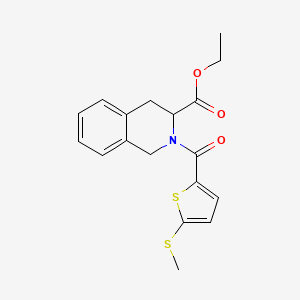Ferroptosis-centered Drug Response Information
General Information of the Drug (ID: ferrodrug0323)
| Name |
SR8278
|
||||
|---|---|---|---|---|---|
| Synonyms |
SR8278; 1254944-66-5; SR 8278; SR-8278; ethyl 2-{[5-(methylsulfanyl)thiophen-2-yl]carbonyl}-1,2,3,4-tetrahydroisoquinoline-3-carboxylate; CHEMBL4754504; ethyl 2-(5-(methylthio)thiophene-2-carbonyl)-1,2,3,4-tetrahydroisoquinoline-3-carboxylate; ethyl 2-(5-methylsulfanylthiophene-2-carbonyl)-3,4-dihydro-1H-isoquinoline-3-carboxylate; 1,2,3,4-Tetrahydro-2-[[5-(methylthio)-2-thienyl]carbonyl]-3-isoquinolinecarboxylic acid ethyl ester; GTPL2904; SCHEMBL20488638; DTXSID80693813; SR8278, >=98%, semisolid; EX-A4711; BDBM50560413; AKOS024458171; AC-36621; AS-16390; HY-14415; CS-0003348; D80535; A899051; J-005234; Q27088866; ethyl2-(5-methylsulfanylthiophene-2-carbonyl)-3,4-dihydro-1H-isoquinoline-3-carboxylate
Click to Show/Hide
|
||||
| Status |
Preclinical
|
||||
| Drug Type |
Small molecular drug
|
||||
| Structure |
 |
||||
| Formula |
C18H19NO3S2
|
||||
| IUPAC Name |
ethyl 2-(5-methylsulfanylthiophene-2-carbonyl)-3,4-dihydro-1H-isoquinoline-3-carboxylate
|
||||
| Canonical SMILES |
CCOC(=O)C1CC2=CC=CC=C2CN1C(=O)C3=CC=C(S3)SC
|
||||
| InChI |
InChI=1S/C18H19NO3S2/c1-3-22-18(21)14-10-12-6-4-5-7-13(12)11-19(14)17(20)15-8-9-16(23-2)24-15/h4-9,14H,3,10-11H2,1-2H3
|
||||
| InChIKey |
UIEBLUZPSFAFOC-UHFFFAOYSA-N
|
||||
| PubChem CID | |||||
| TTD Drug ID | |||||
Full List of Ferroptosis Target Related to This Drug
Phospholipid hydroperoxide glutathione peroxidase (GPX4)
| In total 1 item(s) under this Target | |||||
| Experiment 1 Reporting the Ferroptosis-centered Drug Act on This Target | [1] | ||||
| Target for Ferroptosis | Suppressor | ||||
| Responsed Disease | Aristolochic acid nephropathy | ICD-11: GB55 | |||
| Responsed Regulator | Nuclear receptor subfamily 1 group D member 1 (NR1D1) | Driver | |||
| Pathway Response | Ferroptosis | hsa04216 | |||
| Glutathione metabolism | hsa00480 | ||||
| Cell Process | Cell ferroptosis | ||||
| In Vitro Model | mRTECs (Mouse renal tubular epithelial cells) | ||||
| M4100-57 (Mouse renal tubular epithelial cells) | |||||
| In Vivo Model |
Wild-type C57BL/6 mice (eight-week-old, male) were obtained from SPF Biotechnology (Beijing, China). Three sets of animal experiments were performed. In the first set of experiments, male wild-type mice (eight-week-old) were randomly assigned to three groups (n = 6 per group): control group, 2.5 mg/kg AAI group, and 5 mg/kg AAI group. The AAI groups of mice were intraperitoneally injected with AAI (2.5 or 5 mg/kg) once daily for 5 days. The control group of mice were treated with vehicle (corn oil). In the second set of experiments, male Rev-erbfl/fl and Rev-erbkKO mice (eight-week-old) were treated with AAI (5 mg/kg) or vehicle once daily for 5 days by intraperitoneal injection. In the third set of experiments, male wild-type mice (eight-week-old) were randomly divided into the following four groups (n = 6 per group): AAI + SR8278, AAI + DFO, AAI, and vehicle.
Click to Show/Hide
|
||||
| Response regulation | Renal REV-ERB protein was significantly increased in aristolochic acid I-treated mice. Furthermore, knockdown of Rev-erb by siRNA or SR8278 (a REV-ERB antagonist) treatment attenuated ALI-induced ferroptosis in mRTECs. SR8278 treatment enhanced the cell survival and GPX4 expression in ALI-treated mRTECs. Taken together, small molecule antagonism of REV-ERB alleviates aristolochic acid I-induced renal injury probably through inhibiting ferroptosis in mice. | ||||
